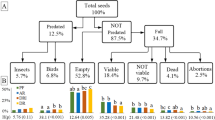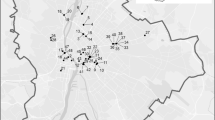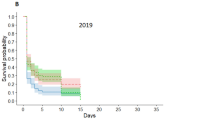Abstract
South American Polylepis mountain forests are recognised as being one of the most endangered forest ecosystems in the world. Reforestation measures have been strongly recommended but may be hampered due to the very low seed germination reported for several Polylepis species. In order to facilitate reforestation we analysed the influence of seed mass on germination probability for Polylepis australis seeds in the Córdoba mountains (central Argentina). We collected seeds from 43 trees distributed throughout five woodland fragments located within two regions differing in size, topographical position, and altitude (1,900 m a.s.l. and 2,200 m a.s.l.). Seeds of Polylepis australis exhibited a great variation in terms of mass and percent seed germination among individual trees and among geographical regions. The results of logistic regression showed that germination probability was highly correlated with seed mass. However, the explained deviance significantly increased by including the region, the woodland fragment and especially the individual tree in addition to seed mass in the regression models. We conclude that selecting seeds on the basis of mass is an appropriate way to enhance germination prospects for reforestation projects. However, no absolute mass values are applicable in this context as the highest germination probabilities were reached at varying seed mass values depending on geographical region, woodland fragment or individual tree. We suggest collecting the relatively heaviest available seeds, even though the absolute seed mass may be low.



Similar content being viewed by others
References
Arista M, Oritz PL, Tavalera S (2001) Reproductive cycles of two allopatric subspecies of Juniperus oxycedrus (Cuppressaceae). Flora 196:114–120
Baskin CC, Baskin JM (1998) Seeds, ecology, biogeography, and evolution of dormancy and germination. Academic Press, San Diego
Cabido M (1985) Las comunidades vegetales de la Pampa de Achala. Sierras de Córdoba, Argentina. Doc Phyt 9:431–443
Cabido M, Acosta A (1985) Estudio fitosociologico en bosques de Polylepis australis Bitt. («tabaquillo») en las Sierras de Córdoba, Argentina. Doc Phyt 9:385–400
Campbell DR, Halama DJ (1993) Resource and pollen limitations to lifetime seed production in a natural plant population. Ecology 74:1043–1051
Chacón P, Bustamante RO (2001) The effects of seed size and pericarp on seedling recruitment and biomass in Cryptocarya alba (Lauraceae) under two contrasting moisture regimes. Plant Ecol 152:137–144
Cingolani AM, Cabido MR, Renison D, Solís Neffa V (2003) Combined effects of environment and grazing on vegetation structure in Argentine granite grasslands. J Veg Sci 14:223–232
Cingolani AM, Renison D, Zak MR, Cabido MR (2004) Mapping vegetation in a heterogeneous mountain rangeland using Landsat data. An alternative method to define and classify land-cover units. Remote Sens Env 92:84–97
Cordazzo CV (2002) Effect of seed mass on germination and growth in three dominant species in southern Brazilian coastal dunes. Braz J Biol 62:427–435
Crawley MJ (2003) Statistical computing. An introduction to data analysis using S-Plus. Wiley, Chichester, England
Díaz S, Acosta A, Cabido M (1994) Community structure in montane grasslands of central Argentina in relation to land use. J Veg Sci 5:483–488
Ellenberg H (1979) Man’s influence on tropical mountain ecosystems in South America. J Ecol 67:401–416
Enrico L, Funes G, Cabido M (2004) Regeneration of Polylepis australis Bitt. in the mountains of central Argentina. For Ecol Man 190:301–309
Fenner M (1992) Seeds. The ecology of regeneration in plant communities. CABI Publishing, Wallingford, Oxon
Fjeldså J, Kessler M (1996) Conserving the biological diversity of Polylepis woodlands of the highland of Peru and Bolivia. A contribution to sustainable natural resource management in the Andes. NORDECO, Copenhagen, Denmark
Galloway LF (2001) The effect of maternal and parental environments on seed characters in the herbaceous plant Campanula americana (Campanulaceae). Am J Bot 88:832–840
Garcia D, Zamora R, Gomez JM, Jordano P, Hodar JA (2000) Geographical variation in seed production, predation and abortion in Juniperus communis throughout its range in Europe. J Ecol 88:436–446
Gómez JM (2004) Bigger is not always better. Conflicting selective pressures on seed size in Quercus ilex. Evolution 58:71–80
Griffen LR, Wilczek AM, Bazzaz FA (2004) UV-B affects within-seed biomass and chemical provisioning. New Phytol 162:167–171
Hendrix SD, Nielsen E, Nielsen T, Schutt M (1991) Are seedlings from small seeds always inferior to seedlings from large seeds? Effects of seed biomass on seedling growth in Pastinaca sativa L. New Phytol 119:299–305
Hensen I (1994) Estudios ecológicos y fenológicos sobre Polylepis besseri Hieron en la Cordillea Oriental Boliviana. Ecol Bolivia 23:21–32
Kessler M (1995) Polylepis-Wälder Boliviens: Taxa, Ökologie, Verbreitung und Geschichte. Diss. Bot. 246. J. Cramer, Berlin, Stuttgart
Kidson R, Westoby M (2000) Seed mass and seedling dimensions in relation to seedling establishment. Oecologia 125:11–17
Lacey EP (1996) Parental effects in Plantago lanceolata L. I.: a growth chamber experiment to examine pre- and postzygotic temperature effects. Evolution 50:865–878
Lacey EP, Smith S, Case AL (1997) Parental effects on seed mass: seed coat but not embryo/endosperm effects. Am J Bot 84:1617–1620
Leishman MR, Westoby M, Jurado E (1995) Correlates of seed size variation. A comparison among five temperate floras. J Ecol 83:517–530
Leishman MR, Westoby M (1998) Seed size and shape are not related to persistence in soil in Australia in the same way as in Britain. Func Ecol 12:480–485
Leishman MR (1999) How well do plant traits correlate with establishment ability? Evidence from a study of 16 calcareous grassland species. New Phytol 141:487–496
Leishman MR (2001) Does the seed size/number trade-off model determine plant community structure? An assessment of the model mechanisms and their generality. Oikos 93:294–302
Milberg P, Andersson L, Elfverson C, Regner S (1996) Germination characteristics of seeds differing in mass. Seed Sci Res 6:191–197
Renison D, Cingolani AM (1998) Experiencias en germinación y reproducción vegetativa aplicados a la reforestación con Polylepis australis (Rosaceae) en las Sierras Grandes de Córdoba, Argentina. AgriScientia 15:47–53
Renison D, Cingolani AM, Suarez R (2002a) Efectos del fuego sobre un bosquecillo de Polylepis australis (Rosaceae) en las montañas de Córdoba, Argentina. Rev Chil Hist Nat 75:719–727
Renison D, Cingolani AM, Schinner D (2002b) Optimizing restoration of Polylepis australis woodlands: when, where and how to transplant seedlings to the mountains? Ecotropica 8:219–224
Renison D, Hensen I, Cingolani AM (2004) Anthropogenic soil degradation affects seed viability in Polylepis australis mountain forests of central Argentina. For Ecol Man 196:327–333
Reynel C, Leon J (1990) Arboles y arbustos andinos para agroforestería y conservación de suelos. Tomo II. Proyecto FAO-Holanda/DGFF. Ministerio de Agricultura/FAO, Lima
Shaukat SS, Siddiqui ZS, Aziz S (1999) Seed size variation and its effects on germination, growth and seedling survival in Acacia nilotica subsp. indica (Benth.) Brenan. Pak J Bot 31:253–263
Simpson BB (1979) A revision of the Genus Polylepis (Rosaceae. Sanguisorbeae). Smithsonian contributions to botany 43. Smithsonian Institution Press, Washington, pp 1–62
Stamp NE (1990) Production and effect of seed size in a grassland annual (Erodium brachycarum, Geraniaceae). Am J Bot 77:874–882
Stephenson AG (1981) Flower and fruit abortion: proximate causes and ultimate functions. Ann Rev Ecol Syst 12:253–279
ter Braak CJF, Looman CWN (1995) Regression. In: Jongman RHG, ter Braak CJF, van Tongeren OFR (eds) Data in community and landscape ecology. Cambridge University, London, 299 pp
UNEP-WCMC (2004) United Nations Environment Programme. World Conservation Monitoring Center, www.unep-wcmc.org
Vera ML (1997) Effects of altitude and seed size on germination and seedling survival of heathland plants in north Spain. Plant Ecol 133:101–106
Walter KS, Gillett HJ (eds) (1998) 1997 IUCN red list of threatened plants. Compiled by the world conservation monitoring center. IUCN – The World Conservation Union, Gland, Switzerland
Acknowledgements
We thank the Volkswagen foundation for supporting this project, the Club Andino Córdoba and Villa Carlos Paz for providing lodging in the field, and the National Parks Administration (Argentina) for providing working permits.
Author information
Authors and Affiliations
Corresponding author
Rights and permissions
About this article
Cite this article
Seltmann, P., Leyer, I., Renison, D. et al. Variation of seed mass and its effects on germination in Polylepis australis: implications for seed collection. New Forests 33, 171–181 (2007). https://doi.org/10.1007/s11056-006-9021-8
Received:
Accepted:
Published:
Issue Date:
DOI: https://doi.org/10.1007/s11056-006-9021-8




